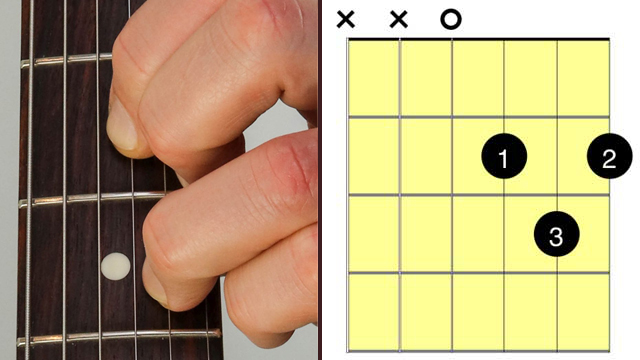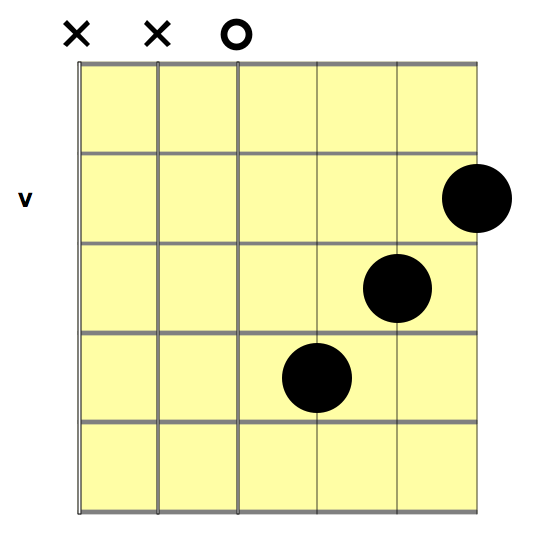
One of the cool things about the guitar is that, even if you can’t read standard music notation, there are several types of guitar-specific notation that can be extremely helpful in learning new chords, scales, and songs. And even if you do know how to read standard notation, knowing how to read guitar-specific notation can save a lot of time and is an essential skill for a well-rounded guitarist. So I’m going to cover different types of guitar notation in a four-part series of articles. Part 1 (this article) deals with chord boxes while Parts 2, 3, and 4 take a look at fretboard diagrams, guitar tablature, and slash notation.
Chord Boxes
Chord boxes are pretty self-explanatory and you’ve probably seen them a million times, but it’s worth reviewing them since they’re used so often.
A chord box (or “chord diagram”) is a simplified representation of the guitar fretboard that shows how to finger a chord. The fretboard is depicted as though you’re facing the guitar, looking straight at it, so the thin (1st) E string is on the right and the thick (6th) E string is on the left. Dots are used to indicate which frets should be fingered to play the chord. Sometimes these dots contain numbers, which tell you which fingers to use.
If no fret numbers are given, and if the top of the fretboard has a darker or thicker line indicating the guitar nut, then the chord chart is showing first position or open position. If a fret number is given, then that tells where on the fretboard the chord is played. Fret numbers are often (but not always) displayed as Roman numerals. (So, for example, “VII” indicates the 7th fret.)
At the top of the diagram, open strings that should be played are indicated by an “o” and strings that should not be played at all, or that should be muted, are indicated by an “x”. But enough yapping—let’s take a look at one…
Here’s a chord chart for an E minor chord, which tells us the following:
- We know that this is an open chord in first position) because the bar at the top is a little darker, representing the nut. Also, there are no fret numbers displayed.
- The 2nd (middle) finger of the left hand plays the 2nd fret of the 5th (A) string.
- The 3rd (ring) finger of the left hand plays the 2nd fret of the 4th (D) string.
- All the other strings are open and are played when you strum the chord.
- Note that there is a fret marker—a dot—in the center of the fretboard between the 2nd and 3rd fret. Dots like this correspond to the fret markers that appear on the 3rd, 5th, 7th, 9th, and 12th frets of most guitars. Sometimes these appear on chord boxes (like here) but usually they’re omitted.
For another example, let’s take a look at the chord box for a D minor chord. This diagram illustrates a few differences:
- The roman numeral “V” indicates that the first note is played on the fifth fret. So we’re not in first position here.
- The fretboard doesn’t include a marker dot.
- The “x” symbol above the 5th and 6th strings indicate that those strings should not be played. (Technically, for this particular chord, you could also play the 5th string, since A is one of the notes in D minor. But that’s a separate issue.)
- The “o” above the 4th string means that open string should be played.
- The three fingered notes do not contain numbers that indicate which fingers should be used. It’s very common for chord boxes to just display the dots without the finger numbering.

One other notation to keep in mind involves the display of barre chords. If you’re just starting to play, you might not be too familiar with these but a barre (pronounced “bar”) chord is a chord in which one finger flattens out and plays two or more notes. They’re incredibly useful and used all the time on the guitar but it usually takes beginners a little while to build up the hand strength to play them. But it’s still worth talking about how they’re notated in a chord box.
There is no one standard for representing barre chords but typically they will be shown using a curved line, a straight line, or separate dots. Take a look at the three diagrams below, which all show the same barre chord, just using different notation. In each case, the 1st (index) finger is held flat against the fretboard to play all the notes on that fret. If you know how to play barre chords, you’ll understand what I mean; if not, no need to worry about this just yet. Just be aware of what the different notations mean in case you see them somewhere.
That’s it for chord boxes! Pretty easy stuff. Now check out the next lesson in this mini-series on guitar notation, which talks about fretboard diagrams. (Also easy!)






Thanks so much. I have been playing guitar fluently for 50 years , but can only follow basic chord notation. Usually my brain freezes up when I attempt to understand anything more complex. BUT, after this first lesson , my brain is still alive, so I am hopeful.
I’m glad it helped–thanks for the feedback!